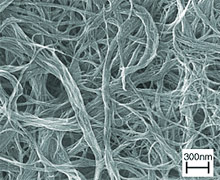Car batteries as we know them today may soon be relics. Storing energy in clunky containers with limited shelf lives has plagued car makers and military engineers who need lightweight, powerful and reliable means to crank engines into life, enliven radios and operate other electronic appliances.
But research by post-doctoral Researcher Jiyoung Oh and Research Scientist Mikhail “Mike” Kozlov at UT Dallas’ NanoTech Institute offers tantalizing insights into a new, lightweight, reliable means of delivering power via the mighty supercapacitor.
“We were extremely proud to see the scanning electron micrograph of our carbon nanotube sheet on the cover of this research journal,” Kozlov said. “The focus of this journal is on important accomplishments in the field of conductive polymers and molecular electronics.”
Supercapacitors are beefed-up electronic components that can be charged and counted on to store energy reliably for long periods. They deliver power in a smooth, steady stream safe for operating sensitive electronics. Unlike car lead batteries, which are typically heavier and bulker, capacitors and super-capacitors accumulate electric charge instead of delivering it via a chemical reaction.
Being lightweight, reliable, safe and efficient while also offering a steady stream of power is a prized set of attributes that technology designers readily seek out. But how do they bridge the gap between current designs that call for batteries and the virtually limitless design possibilities offered when supercapacitors offer up power and the battery box disappears? That’s where Drs. Oh and Kozlov step in.
The team, along with legendary nanotechnology pioneer Dr. Ray Baughman, developed a means to create supercapacitors using “paper” sheets of single-walled carbon nanotubes embedded with a special polymer called polypyrrole.
Imagine if the boxy, heavy car battery morphed into something light, strong, perhaps paper-thin and flexible that could be molded to fit elsewhere in the vehicle—even hidden in plain sight. Getting rid of the weight and bulk of batteries could prove especially helpful in hybrid car designs, which today rely on a suitcase-sized array of hefty, metal batteries. And that’s just one application.
“Our electrode preparation procedure is an extension of conventional bucky-paper [a film made of 100 percent carbon nanotubes] fabrication technique for the multi-component system,” Oh said. “This procedure is easily scalable for device fabrication on an industrial scale.”
This team’s research was supported in part by the International Research Internship Program of the Korea Research Foundation, a Korea Research Foundation Grant, a Robert A. Welch Foundation grant and funds from the LINTEC Corporation—a firm that collaborates with UT Dallas’ NanoTech Institute on supercapacitor research.

